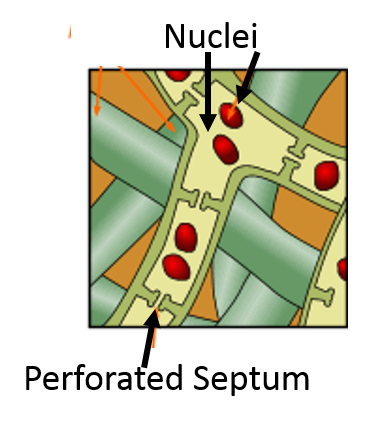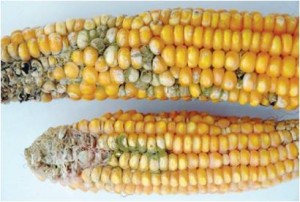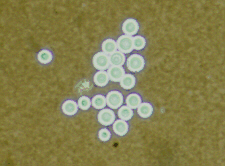Fungi
Fungi are plant-like and were once classified with plants, but fungi lack chlorophyll and differ in other ways from plants, so they are now classified in a separate kingdom. However, they are often mutualistic, living with other species, e.g. lichens (algae + fungus), and growing in a symbiotic relationship on rocks & trees. Fungi are saprophytes that decompose dead organic matter by growing into a substrate & absorb nutrients from it. Parasitic fungi often feed on living organisms without killing them (e.g. ringworm & athletes foot). Fungi are structurally different from plants. Fungi are generally composed of branching filaments ("hyphae
that decompose dead organic matter by growing into a substrate & absorb nutrients from it. Parasitic fungi often feed on living organisms without killing them (e.g. ringworm & athletes foot). Fungi are structurally different from plants. Fungi are generally composed of branching filaments ("hyphae ") that sometimes form a large interlacing mass called a "mycelium
") that sometimes form a large interlacing mass called a "mycelium ." The hyphae have cross walls, but they are perforated allowing free passage of nuclei and cytoplasm. Unlike plants, fungi are not truly multi-cellular.
." The hyphae have cross walls, but they are perforated allowing free passage of nuclei and cytoplasm. Unlike plants, fungi are not truly multi-cellular.

Like bacteria, fungi provide many benefits. In conjunction with bacteria, they are important in breaking down dead organic material & recycling nutrients through ecosystems. Fungi supply nutrients to the roots of many plants, and they also provide a source of antibiotics. In addition, they provide food (mushrooms, truffles), make bread rise, and enable fermentation of sugar to alcohol. The tabbed activity below shows some of the forms the fungi take that may be familiar to you.
 |
Roll over the tabs to see the definitions of these terms. |
|
This content requires JavaScript enabled.
|
|
Like bacteria, fungi can comprise part of our normal flora. For example, Candida species are common fungi that are normal flora on our skin and in our respiratory, genital, and digestive tracts. Candida is normally kept in check by other normal flora as well as our immune system. Yet they can cause infections which can be mild (diaper rash and vulvar rash) or severe (oral thrush, esophagitis, and rapidly fatal systemic diseases in immunocompromised people). Candida is usually a yeast, but can form hyphae.

Fungal Infection
Fungi also cause a number of diseases in plants and animal e.g. ringworm, athlete's foot. Because fungi are more chemically and genetically similar to animals than to other organisms, fungal diseases are often very difficult to treat.
From the CDC web site:
"Fungi interact with humans, animals, and plants in a variety of ways. Some of these interactions can be beneficial; for example, both penicillin and bread use ingredients made from fungi. However, certain types of fungi can be harmful to health. Like bacteria and viruses, some fungi can act as pathogens. Human fungal diseases can occur due to infection or fungal toxins.
Why are fungal diseases a public health issue?
Mycotic (fungal) infections pose an increasing threat to public health for several reasons. The scientific and medical staff of the Mycotic Diseases Branch is involved with prevention and control among three broad categories of fungal infections:
- Opportunistic infections such as cryptococcosis and aspergillosis are becoming increasingly problematic as the number of people with weakened immune systems
 rises.
rises. - Hospital-associated infections such as candidemia are a leading cause of bloodstream infections in the United States. Advancements and changes in healthcare practices can provide opportunities for new and drug-resistant fungi to emerge in hospital settings.
- Community-acquired infections such as coccidioidomycosis (Valley Fever), blastomycosis, and histoplasmosis, are caused by fungi that are abundant in the environment. These types of fungi live in the soil, on plants, or in compost heaps, and are endemic
 throughout much of the U.S. Climate change may be affecting these fungi, as even small changes in temperature or moisture can affect their growth." See this New York Times article on "Valley Fever" in California in 2013.
throughout much of the U.S. Climate change may be affecting these fungi, as even small changes in temperature or moisture can affect their growth." See this New York Times article on "Valley Fever" in California in 2013.
Rogues Gallery of Fungal Infections
The table below provides some examples of fungal diseases, with links to additional information sheets from the CDC.
Fungal Toxins
Fungi also produce some interesting toxins which are products of a fungus' secondary metabolism, i.e. that part of fungal metabolism that is not essential for cell growth and maintenance of basic cell function. Why fungi produce such substances is not entirely clear, but they may, at least in part, be used for "chemical warfare" and provide some survival advantage in the environment.
Aspergillus mold can grow on peanuts, corn, and grain.

Ergot fungus infects various cereal plants and forms compact black masses of branching filaments that replace many of the grains of the host plant.

Aflatoxin
Aspergillus mold is virtually unavoidable. Outdoors, it's found in decaying leaves and compost and on plants, trees and grain crops. The spores thrive in air conditioning and heating ducts, insulation, and some foods and spices. Aspergillus is so common in old buildings, even in older hospitals, that small epidemics have occurred among people with weakened immune systems when nearby buildings have been torn down. Everyday exposure to aspergillus is rarely a problem for people with healthy immune systems.
Certain species of the Aspergillus mold can produce toxins (aflatoxins) that can be metabolized to chemicals that have a high affinity for DNA. Their binding to DNA can cause mutations that can contribute to the development of a cancer. Aflatoxins are carcinogenic in rats, ducks, mice, trout & subhuman primates. Trout are the most susceptible; just 1 ppb (part per billion) of aflatoxin B1 will cause liver cancer in trout. Some studies indicate that aflatoxins increase the risk of liver cancer in humans who are hepatitis B carriers.
In 2004 there was a widespread outbreak of human aflatoxin poisoning in eastern and central Kenya as a result of aflatoxin contamination of locally grown maize, which occurred during storage of the maize under damp conditions. Affected individuals had jaundice and a high case-fatality rate.
rate.
Ergot
Ergotism is a condition caused by poisoning with an alkaloids produced by the Claviseps pupurea fungus which infects cereals, especially rye. Intoxication can produce neurological symptoms (e.g., a burning or prickling sensation, or hallucinations, or psychosis). Some believe that ergot poisoning was responsible for the strange behaviors observed among young women in Salem, which resulted in the Salem witch trials. Ergotism can also cause severe constriction of blood vessels, resulting in gangrene. Episodes of ergotism occurred periodically in the Middle Ages, when it was known as "St. Anthony's Fire" because of the sensation of burning skin which occurred with the gangrenous form. Developed countries have controlled ergotism through carefully monitoring, but it still remains a potential threat in developing countries.








